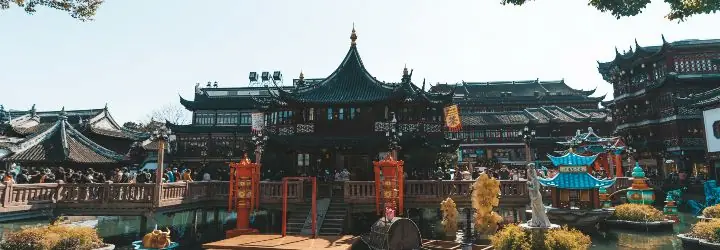Discover sacred temples in Shanghai

Any trip to the Far East is going to be a memorable one. The region can feel for many like a step into the unknown but the culture and customs are worth the trip alone.
Countries such as Vietnam, Cambodia and Thailand have become popular amongst those wanting a taste of the Far East, whilst China also remains a great location for a holiday. It is not just the culture that keeps people coming back, it is the amazing architecture that populates these countries. Shanghai in particular boasts a host of historic temples.
The largest city by population in the world, Shanghai combines both the modern with the traditional. While the centre is home to some of the planet's biggest businesses, Shanghai stays true to its heritage with a large number of historic temples remaining nearby. With Iglu offering cruises to the Chinese city, why not check out some of these traditional places of spirituality? Here is our rundown of the best temples Shanghai has to offer.
Jade Buddha Temple
By far the most famous temple in Shanghai, the Jade Buddha is an iconic image of the city. Founded in 1882, the structure draws from both the Pure Land and Chan traditions of Mahayana Buddhism. It is an intriguing place to stroll around and learn about the history of the temple while gazing upon the many statues.
In the Jade Buddha itself is the Chamber of Four Heavenly Kings, which contains images of Maitreya, Wei Tuo Bodhisattva and the Four Heavenly Kings. These figures represent favourable circumstance and good fortune.
There is also the Grand Hall which features the statues of the Three Golden Buddhas (Gautama Buddha, Amitabha and Bhaisajyaguru), the Gods of the Twenty Heavens which are covered in gold on the eastern and western sides of the Grand Hall and of course the 18 Arhats, statues of what the Buddhists consider to be "perfected people".
Jing'An Temple
Translated as the Temple of Peace and Tranquillity, the Jing'An Temple perfectly portrays modern day Shanghai. It can trace its history back to 247 AD but set against the backdrop of towering skyscrapers, it highlights the juxtaposition between the historic side of Shanghai and its now urban metropolis.
Built in the Wu Kingdom during the Three Kingdoms period of ancient China and having sat in the same location beside the Suzhou Creek since 1216, the features of the Jing'An Temple are simply remarkable.
It has three Southern-style main halls each with its own courtyard dating back to 1880. Among the main features is the Guanyin Hall, which is made out of camphor wood along, with paintings by master artists such as Chu Zhishan, Zhang Daqian and Wen Zhenming.
Wen Miao
The Shanghai Wen Mao is one of the understated temples in Shanghai and is set away from the city centre. However, it is one of major spirituality and pays homage to Confucius, a legendary ancient Chinese philosopher who lived between 551 and 479 BC. It is similar to the original Temple of Confucius in his hometown Qufu but smaller in its stature.
Wen Miao was first founded during the Yuan Dynasty and quickly became the most prestigious learning institution in Shanghai, when it gained the status of a county. A visit is not complete without viewing the bizarre-shaped stones and wood and, of course, the Kuixing Pavilion which is situated in the western part of the compound.
Chenghuang Miao
Moving back into the centre of Shanghai and Chenghuang Miao is another must when visiting the city's temples. Translated as The City God Temple, Chenghuang is dedicated to three city gods - Huo Guang, Qin Yubo and Chen Huacheng.
The former was a famous Han Dynasty chancellor and is known for overthrowing a young emperor and replacing him with another. Qin Yubo lived in Shanghai during the 12th and 13th centuries and served as the Imperial examiner for the Hongwu Emperor before his death in 1373.
Chen Huacheng was a Qing Dynasty general and helped to defend Shanghai from the British during the First Opium War.
The temple acts as a shrine to these city gods and is adjoined to the famous Yuyuan Garden.